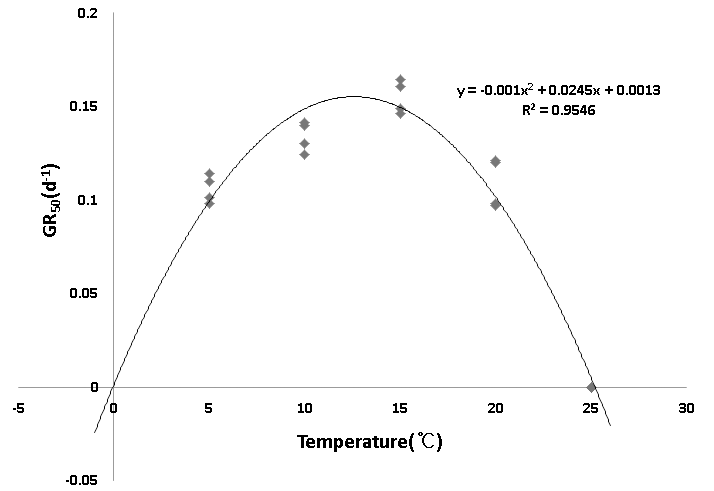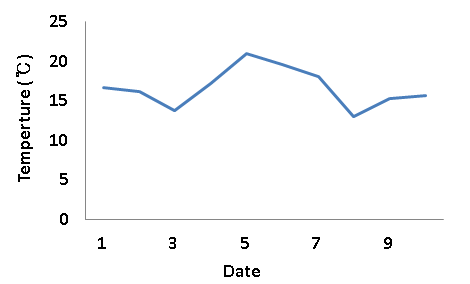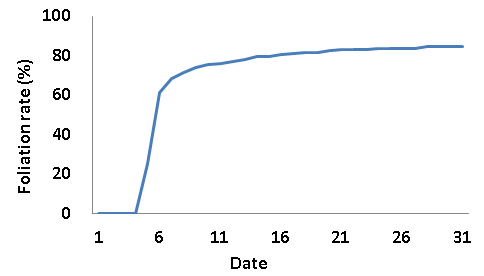도시 녹화를 위한 녹화기법에 있어 Parabolic 함수에 의한 Centaurea cyanus L. 종자의 발아 주요온도 분석
Analysis Cardinal Temperatures of Centaurea cyanus L. Seed by Parabolic Function for Greening City in Greenery Cover Method
Article information
Abstract
Among landscaping techniques, seed spray refers involves spraying a mix of seeds, fertilizers and other ingredients, and it is primarily used when landscaping large areas. The requisite time for sprayed seeds to form a landscape differs depending on temperature conditions however the correlation between plant growth and temperature is not given consideration. This research aims to setup the appropriate temperature and requisite time for cornflower seeds germination, in order to utilize them efficiently. The study was conducted at the National Institute of Horticultural and Herbal Science between March and April 2013. Centaurea cyanus L. was the test material selected for this research, and subjects received thermal treatment using a growth chamber. The test method involved four repetitions of placing 100 seeds in petri dishes and filter paper, and supplying 10ml of distilled water for seven different levels of processing temperatures. Processing temperatures were set at 5,10,15,20,25,30°C. During the experiment, the light source was maintained at 4~4.5μmoles/m2/s. For indoor experiments, the germination rate was measured every two days after placing the test subjects in the petri dish. Plotting the correlation between temperature and time to germination using a parabolic function, at a 50% germination rate, revealed a minimum temperature of 0°C, optimal temperature of 12.3°C, and maximum temperature of 24.5°C. Moreover, the time it took to reach a 50% germination rate was 6.6 days at the optimal temperature.
I. 서론
시민들의 도시녹지와 경관에 대한 사회적 요구도는 점점 높아지 고 있다. 경관 조성 기법 중 seed spray는 종자, 비료 및 기타 재료들 을 섞어 살포하는 방법으로 주로 도로, 사방공사, 하천, 운동장, 골 프장, 스키장 등과 같이 대면적의 경관을 조성할 때 주로 사용되는 기법이다. 살포된 종자는 온도조건에 따라 경관형성 소요시간은 달 라지나 대부분의 작업장에서는 식물생장과 온도간의 관계를 고려 하지 않고 시공되고 있다.
온도는 식물의 성장에 있어 중요한 요인으로 작용한다(Yan and Hunt, 1999). 식물의 최적온도는 15~30°C, 최고온도는 30~40°C 이고 발아를 위한 주요온도는 종에 따라 차이가 있다(Ren et al., 2005). 식물의 생장율과 온도간의 관계를 나타낸 개념은 growing degree-days(GDD)라 부른다(Rezazadeh and Koocheki, 2006).
현재 종자발아에 관한 연구는 온도에 따른 주걱쑥부쟁이 종자의 발아 특성(Lee and Nam, 2009), 할미꽃 종자의 발아 적온 연구 (Sang et al., 1993), 냉이, 며느리배꼽, 닭의장풀 종자의 발아 적온 연구(Yang and Kim, 1993), 돼지풀 종자의 온도에 따른 발아율 연 구(Cha et al., 2002), 털머위 종자의 온도에 따른 발아 영향(Choe, 2007), 라벤더 종자발아에 미치는 온도의 영향에 관한 연구(Park et al., 2005)가 진행된 바 있으나 수레국화 종자의 발아 주요온도 및 온도수준에 따른 발아소요시간에 관한 연구는 미비하다.
본 연구의 목적은 수레국화 종자의 효율적인 사용을 위하여 수 레국화 종자발아의 주요온도 및 온도수준에 따른 발아소요시간에 관한 연구에 있다.
II. 연구방법
본 연구는 2013년 3월부터 4월까지 국립원예특작과학원에서 진행되었다. 시험에 사용된 식물종자는 수레국화이며 생장상(DS- 134, Daewon, Korea)을 이용하여 진행하였다. 시험방법은 페트 리디쉬와 필터페이퍼(Whatman No.2, GE Healthcare, UK)에 100립씩 4반복으로 치상 후 10ml씩 1차 증류수를 관수한 이후 5, 10, 15, 20, 25, 30°C 수준으로 온도처리를 하였다. 시험 중 인공광 원은 LED램프를 사용하여 4~4.5μmoles/m2/s 를 유지하였다. 처 리 후 필터페이퍼의 수분 상태를 고려하여 주기적으로 증류수를 관 수하였고 관수 시 처리온도와 동일한 온도의 증류수를 관수하여 시 험의 정밀도를 높였다. 조사방법은 발아율을 조사하였다. 발아의 기준은 유근이 3mm 정도 발생한 시기로 하였으며 페트리디쉬에 치상 후 2일 간격으로 발아율을 조사하였고 7일간 더 이상 발아하 지 않는 시점에 조사를 종료하였다. 수집된 데이터는 로지스틱함수 를 이용하여 발아 최적온도를 분석하였다.
각 처리의 발아율 50% 기준으로 함수를 이용하여 발아율을 예 측하였다. 통계처리에는 SigmaPolt version 10.0(SPSS Inc., Chicago, IL, USA), SAS version 8.2(SAS Institute Inc., Cary, NC, USE)을 활용하였다. 그리고 분석된 데이터를 검증하기 위하 여 온실에서 수레국화의 100립씩 4반복으로 파종하여 출아율을 조 사하였다.
III. 결과 및 고찰
온도 수준별 수레국화종자의 발아율을 조사 하였다. 전체적으로 5°C, 10°C, 15°C, 20°C에서 발아율이 높아지며 정상 발아 경향을 보였으나 25°C, 30°C에서는 발아율이 낮아졌다. 수레국화 종자를 페트리디쉬에 치상 후 최초발아까지 소요된 시간은 5°C에서는 5 일, 10°C, 15°C, 20°C에서는 3일이 소요되었으나 25°C, 30°C에 서는 1일이 소요되었다. 수레국화종자의 최종 발아율은 5°C, 10°C, 15°C, 20°C에서 95.7, 84.3, 83.7, 79.0% 발아율을 보였으며 25°C, 30°C에서 31.7, 12.9% 발아율을 보였다(Fig. 1).

Cumulative germination of Centaurea cyanus L. seeds as influenced by germination temperature. All data are means ± SE of rour replications.
수레국화 종자의 발아율을 로지스틱 함수를 이용한 분석하였다. 최종 발아율은 5°C에서 95.7%로 가장 높았으며 10°C 84.3%, 15°C 83.7%, 20°C 79.0%, 25°C 31.3%, 30°C 12.9%로 나타났다. 최종 발아율까지 소요시간은 온도가 높을수록 짧아지는 경향을 보였으 며 30°C에서는 2.7일로 가장 짧았으며 25°C 4.2일, 20°C 8.2일, 15°C 6.8일, 10°C 7.7일, 5°C 12.6일로 가장 길게 나타났다. 발아 속도 증가율은 30°C에서 4.5으로 높게 나타났으며 25°C 0.9, 20°C 0.3, 15°C 0.6, 10°C 0.5, 5°C 0.9로 나타났다. 전체적으로 온도가 낮을수록 수레국화 종자의 발아율, 발아속도 증가율이 높게 나타났 으나 발아 소요시간은 길게 나타나는 경향을 보였다. 그리고 25, 30°C에서 최종 발아율은 매우 낮게 나타나 고온으로 인하여 수레 국화 종자발아에 장해를 받은 것으로 보인다(Table 1).
Parabolic 함수를 이용하여 발아율 50% 기준으로 온도에 따른 수레국화종자의 발아소요시간의 관계를 통하여 발아 최적온도를 나타내었다. 수레국화 종자의 발아 최저온도는 0°C, 최적온도는 12.3°C, 최고온도는 24.5°C로 나타났다. 또한 최적온도에 따른 발 아율 50%까지 발아소요시간은 6.6일 이었다(Fig. 2).

Estimated germination rate of Centaurea cyanus L., GR50(the time to 50% germination) was calculated by parabolic equation. Estimated equation was y=-0.001x2+0.0245x+0.0013. All date are means±SE of four replications.
6일간 온실의 평균기온은 17.37°C로 나타났으며(Fig. 3) 구하 여진 y=-0.001x2+0.0245x+0.0013 공식에 대입 시 발아율 50% 시 까지 7.99일이 소요될 것으로 계산되었으나 실제 출아율 50% 까지 소요시간은 5.5일로 나타났다(Fig. 4).
연구결과 수레국화종자발아의 온도와 발아소요시간의 관계를 나타내는 함수식은 y = -0.001x2 + 0.0245x + 0.0013 이었다. 함수 식을 검증한 결과 50% 발아 시까지 소요시간은 예측일은 7.99일 이었으나 실제 발아 시까지 5.5일로 나타났다. 예측일과 실제일은 다소 차이를 보였으며 이는 온실의 변온, 수분등의 환경요인 때문 일 것이라 생각된다. 그리고 25°C, 30°C에서의 고온에 의하여 발 아율이 낮아졌다. 이는 고온에 의한 발아억제원인으로 세포막의 구 조적 손상에 의한 대사물질의 유출 때문일 것으로 추측된다 (Hendricks and Taylorson, 1979).
함수식을 이용하여 계산된 수레국화종자의 최저온도는 0°C, 최 적온도는 12.3°C, 최고온도는 24.5°C로 나타났다. 국화과 식물의 종자 발아온도의 유사연구사례로는 발아를 위한 최저온도와 최저 수분포텐셜에 관한 연구에서는 수레국화의 발아최저온도를 1.7°C 로 보고하였고(Gardarin et al., 2010) 국화과 잇꽃 유전체에 따른 발아 시 주요온도연구에서 국화과 잇꽃의 주요온도범위는 최저온 도 2~3°C, 최적온도 25~31°C, 최고온도 37~38°C로 보고하였다 (Balashahri et al., 2013) 그리고 주요온도를 설정에 관한 연구에 서 국화과 쑥부쟁이의 주요온도를 최저온도 7.9°C, 최적온도 24. 8°C, 최고온도 36°C로 보고하였다(Kim et al., 2010). 타 연구사례 와 비교 시 최저온도는 유사한 온도수준을 보였다. 이를 통하여 본 연구에서 계산된 함수식이 유용할 것으로 생각된다. 하지만 최적온 도와 최고온도는 상이한 차이를 보였으며 이는 종간차이, 모본의 생육정도, 종자의 숙도 등에 의한 것으로 생각된다.
연구결과의 활용은 수레국화 발아에 주요온도를 구명함으로써 seed spray 시공 시 일평균 온도조건에 따른 수레국화 종자 사용여 부 및 사용 후 발아까지 소요시간을 예측할 수 있다.
본 연구에서 50% 발아율을 기준으로 수레국화종자 발아 시 주요 온도를 함수식을 이용하여 구명하고 예측 및 실제 검증을 실시하였 다. 하지만 예측값과 실제값에서 다소 차이를 보였으며 이는 함수식 작성 시 발아와 관련된 변온 환경, 수분 등의 환경요인과의 상관관 계를 고려하지 못했기 때문이다. 이 부분에 대하여서는 차후 연구에 반영하여 그 효과를 구명함으로써 함수식을 보완해야 할 것이다.
IV. 적요
Seed spray는 종자, 비료 및 기타 재료들을 섞어 살포하는 방법 으로 주로 대면적의 경관을 조성할 때 주로 사용되는 기법이다. 살 포된 종자는 온도조건에 따라 경관형성 소요시간은 달라지나 시공 시 식물생장과 온도간의 관계를 고려되지 않는다. 본 연구에서는 수레국화 종자의 효율적인 사용을 위하여 수레국화종자발아에 필 요한 적정온도와 발아소요시간을 설정하는데 있다. 시험방법은 2013년 3월부터 4월까지 국립원예특작과학원에서 진행되었다. 시험재료는 수레국화이며 생장상을 이용하여 온도처리를 하였 다. 시험방법은 페트리디쉬와 필터페이퍼에 100립씩 4반복으로 치 상 후 10ml씩 1차 증류수를 관수하여 7수준의 온도를 처리하였 다. 처리온도는 5, 10, 15, 20, 25, 30°C이다. 시험 중 광원은 4~4.5 μmoles/m2/s를 유지하였다. 조사방법은 실내시험에서는 페트리 디쉬에 치상 후 2일 간격으로 발아율을 조사하였다. Parabolic 함 수를 이용하여 발아율 50% 기준으로 온도와 발아소요시간의 관계 나타낸 결과 수레국화 종자의 발아 최저온도는 0°C, 최적온도는 12.3°C, 최고온도는 24.5°C로 나타났다. 그리고 최적온도에 따른 발아율 50%까지 발아소요시간은 6.6일이었다.


